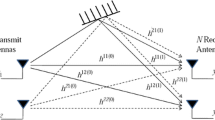Abstract
This paper considers the problem of blind adaptive equalization of infinite impulse response (IIR) channels without requiring the channel diversity condition. That is, the subchannels in the fractionally sampled model can have common factors. We analyze the case of two parallel channels, and develop an equalizer based on IIR prediction of the received signal. The predictor parameters are estimated by using the recursive extended least squares (RELS) algorithm. It is proved that with probability one the adaptive equalizer is globally stable, the parameter estimates are consistent, and the prediction error converges toward a scalar multiple of the input symbol sequence.
Similar content being viewed by others
References
K. Abed-Meraim, E. Moulines, P. Loubaton, Prediction error method for second-order blind identification. IEEE Trans. Signal Process. 45, 694–705 (1997)
C.W. Burill, Measure, Integration and Probability (McGraw-Hill, New York, 1972)
F. Chen, S. Kwong, W. Wie, G. Wie, F. Ji, Blind IIR channel equalization based on second order statistics, in IEEE Vehicular Technology Conference, vol. 5 (2006), pp. 2334–2338
C.Y. Chi, C.C. Feng, C.H. Chen, C.Y. Chen, Blind Equalization and System Identification (Springer, Berlin, 2006)
Y.S. Chow, Local convergence of martingales and the law of large numbers. Ann. Math. Stat. 36, 552–558 (1965)
D. Gesbert, P. Duhamel, Unbiased blind adaptive channel identification and equalization. IEEE Trans. Signal Process. 48, 148–158 (2000)
S. Haykin, Unsupervised Adaptive Filtering, Blind Deconvolution, vol. II (Wiley, New York, 2000)
T. Lai, C.Z. Wei, Least square estimates in stochastic regression models with application to identification and control of dynamic systems. Ann. Stat. 10(1), 154–166 (1982)
A. Liavas, P. Regalia, J.P. Delmas, Robustness of least-squares and subspace methods for blind channel identification/equalization with respect to channel undermodeling. IEEE Trans. Signal Process. 47, 1636–1645 (1999)
H. Liu, G. Xu, Close form blind symbol estimation in digital communication. IEEE Trans. Signal Process. 43, 2714–2723 (1995)
L. Ljung, T. Soderstrom, Theory and Practice of Recursive Identification (MIT Press, Cambridge, 1983)
E. Moulines, P. Duhamel, J. Cardoso, T. Mayrargue, Subspace methods for blind identification of multichannel FIR filters. IEEE Trans. Signal Process. 43, 516–525 (1995)
M. Radenkovic, A. Michel, Verification of the self-stabilization mechanism in robust stochastic adaptive control using Lyapunov function arguments. SIAM J. Control Optim. 30(6), 1270–1294 (1992)
M. Radenkovic, T. Bose, Global stability of adaptive IIR filters based on the output error method and parameter truncation. Circuits Syst. Signal Process. 23(3), 231–255 (2004)
D. Rao, Linear adaptive blind equalization of nonlinear SIMO FIR channels, in IEEE Asia Pacific Conference on Circuits and Systems (Dec. 2006), pp. 1120–1123
P.A. Regalia, Adaptive IIR Filtering in Signal Processing and Control (Dekker, New York, 1995)
A.H. Sayed, Fundamentals of Adaptive Filtering (Wiley-Interscience, New York, 2003)
L. Toug, G. Xu, T. Kailath, Blind identification and equalization based on a second order statics: a time domain approach. IEEE Trans. Inf. Theory 40, 340–349 (1994)
J. Tugnait, B. Huang, Second order statistics based blind equalization of IIR single input multiple outputs with common zeros. IEEE Trans. Signal Process. 47, 147–157 (1999)
J. Tugnait, Multistep linear predictor based blind equalization of FIR/IIR single input multiple output channels with common zeros. IEEE Trans. Signal Process. 47, 1689–1700 (1999)
J. Tugnait, B. Huang, Multistep linear predictor based blind identification and equalization of multiple input multiple output channels. IEEE Trans. Signal Process. 48, 26–38 (2000)
J. Tugnait, A multidelay whitening approach to blind identification and equalization of SIMO channels. IEEE Trans. Wirel. Commun. 1, 456–467 (2002)
Author information
Authors and Affiliations
Corresponding author
Rights and permissions
About this article
Cite this article
Radenkovic, M.S., Bose, T. A Recursive Blind Adaptive Equalizer for IIR Channels with Common Zeros. Circuits Syst Signal Process 28, 467–486 (2009). https://doi.org/10.1007/s00034-008-9095-y
Received:
Revised:
Published:
Issue Date:
DOI: https://doi.org/10.1007/s00034-008-9095-y



